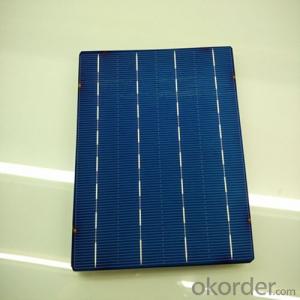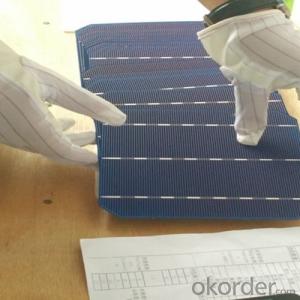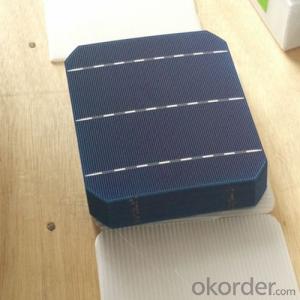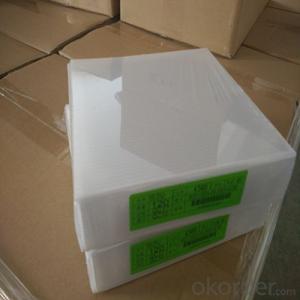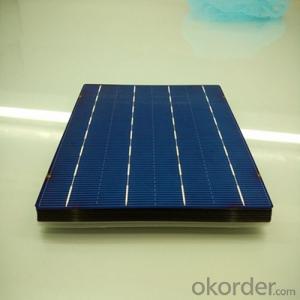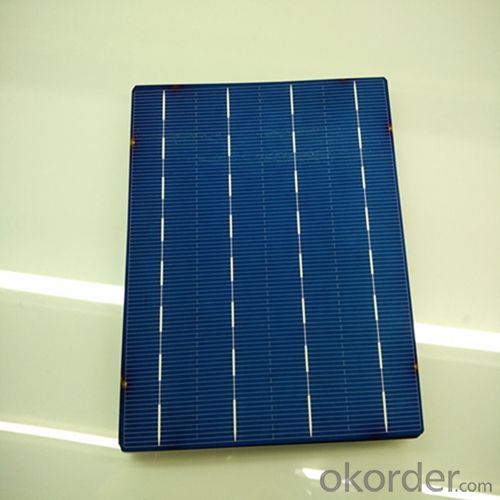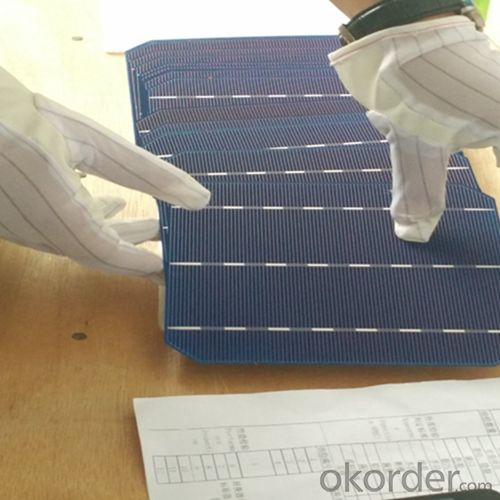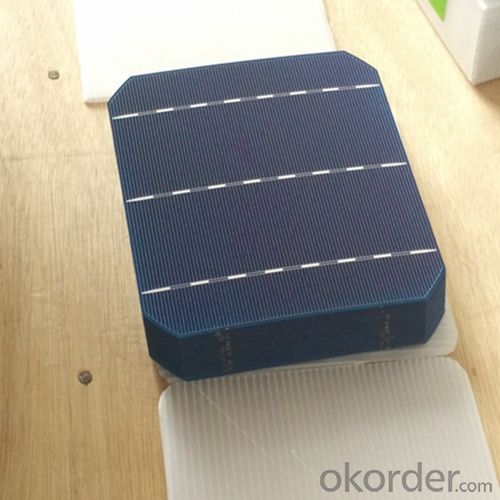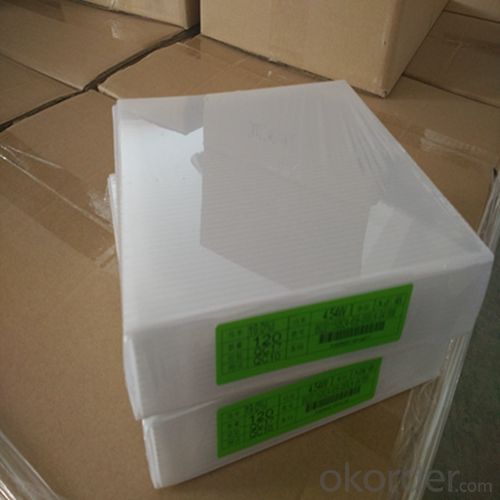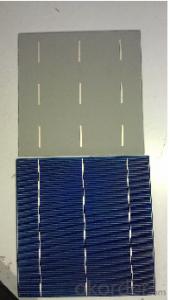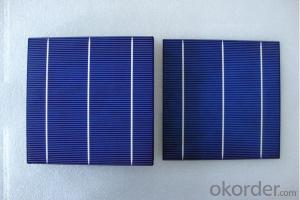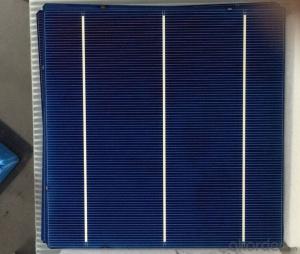Multijunction Solar Cells - Poly 156x156mm2 Class A Solar Cells
- Loading Port:
- Shanghai
- Payment Terms:
- TT OR LC
- Min Order Qty:
- 6500 watt
- Supply Capability:
- 6000000 watt/month
OKorder Service Pledge
OKorder Financial Service
You Might Also Like
The operation of a photovoltaic (PV) cell requires 3 basic attributes:
The absorption of light, generating either electron-hole pairs or excitons.
The separation of charge carriers of opposite types.
The separate extraction of those carriers to an external circuit.
In contrast, a solar thermal collector supplies heat by absorbing sunlight, for the purpose of either direct heating or indirect electrical power generation from heat. A "photoelectrolytic cell" (photoelectrochemical cell), on the other hand, refers either to a type of photovoltaic cell (like that developed by Edmond Becquerel and modern dye-sensitized solar cells), or to a device that splits water directly into hydrogen and oxygen using only solar illumination.Characteristic of Mono 156X156MM2 Solar Cells
You are gaining energy independence - add battery backup power for even greater energy security
The cost of electricity is only going to rise – insure against that rising cost
Adaptive cells change their absorption/reflection characteristics depending to respond to environmental conditions. An adaptive material responds to the intensity and angle of incident light. At the part of the cell where the light is most intense, the cell surface changes from reflective to adaptive, allowing the light to penetrate the cell. The other parts of the cell remain reflective increasing the retention of the absorbed light within the cell.[67]
In 2014 a system that combined an adaptive surface with a glass substrate that redirect the absorbed to a light absorber on the edges of the sheet. The system also included an array of fixed lenses/mirrors to concentrate light onto the adaptive surface. As the day continues, the concentrated light moves along the surface of the cell. That surface switches from reflective to adaptive when the light is most concentrated and back to reflective after the light moves along
Mechanical data and design
Format | 156mm x 156mm±0.5mm |
Thickness | 210μm±40μm |
Front(-) | 1.5mm bus bar (silver),blue anti-reflection coating (silicon nitride) |
Back (+) | 2.5mm wide soldering pads (sliver) back surface field (aluminium) |
Temperature Coefficient of Cells
Voc. Temp.coef.%/K | -0.35% |
Isc. Temp.coef .%/K | +0.024%/K |
Pm.Temp.coef. %/K | -0.47%/K |
Electrical Characteristic
Effiency(%) | Pmpp(W) | Umpp(V) | Impp(A) | Uoc(V) | Isc(A) | FF(%) |
18.35 | 4.384 | 0.526 | 8.333 | 0.63 | 8.877 | 78.39% |
18.20 | 4.349 | 0.526 | 8.263 | 0.63 | 8.789 | 78.54% |
18.05 | 4.313 | 0.525 | 8.216 | 0.63 | 8.741 | 78.32% |
17.90 | 4.277 | 0.524 | 8.161 | 0.625 | 8.713 | 78.04% |
17.75 | 4.241 | 0.523 | 8.116 | 0.625 | 8.678 | 77.70% |
17.60 | 4.206 | 0.521 | 8.073 | 0.625 | 8.657 | 77.36% |
17.45 | 4.170 | 0.519 | 8.039 | 0.625 | 8.633 | 76.92% |
17.30 | 4.134 | 0.517 | 8.004 | 0.625 | 8.622 | 76.59% |
17.15 | 4.096 | 0.516 | 7.938 | 0.625 | 8.537 | 76.80% |
17.00 | 4.062 | 0.512 | 7.933 | 0.625 | 8.531 | 76.18% |
16.75 | 4.002 | 0.511 | 7.828 | 0.625 | 8.499 | 75.34% |
16.50 | 3.940 | 0.510 | 7.731 | 0.625 | 8.484 | 74.36% |
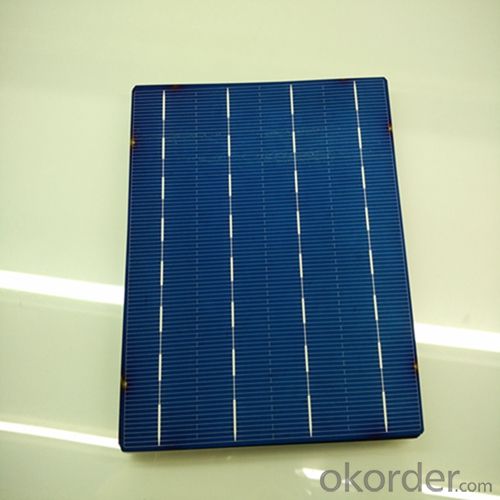
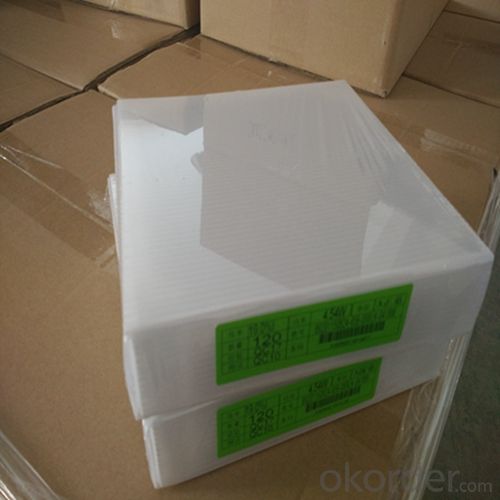
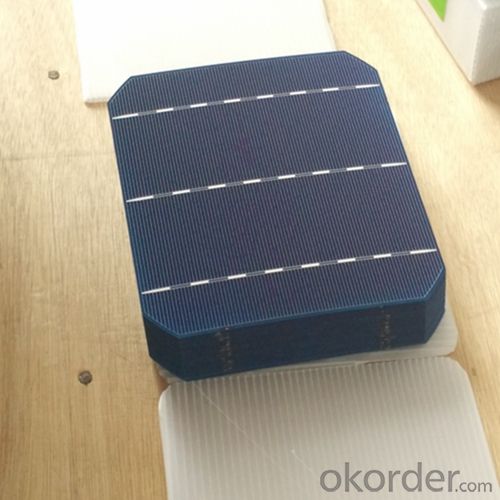
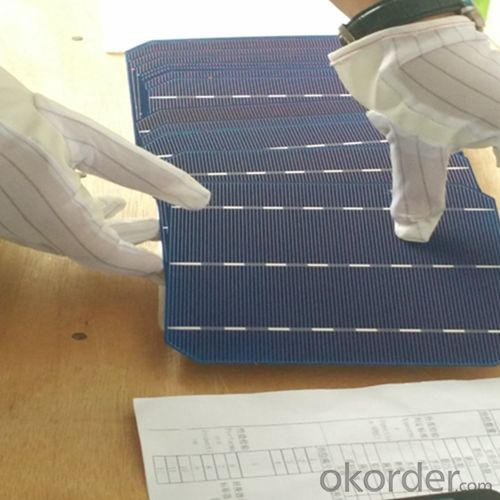
 FAQ
FAQ
Q: What price for each watt?
A: It depends on the quantity, delivery date and payment terms, generally Large Quantity and Low Price
Q: What is your size for each module? Can you tell me the Parameter of your module?
A: We have different series of panels in different output, both c-Si and a-Si. Please take the specification sheet for your reference.
Q: What is your size for each module? Can you tell me the Parameter of your module?
A: We have different series of panels in different output, both c-Si and a-Si. Please take the specification sheet for your reference.
- Q: Can solar cells be used for outdoor lighting?
- Yes, solar cells can be used for outdoor lighting. Solar-powered lights utilize solar cells to convert sunlight into electricity which is stored in batteries during the day. This stored energy is then used to power the lights during the night, making them a sustainable and environmentally-friendly option for outdoor lighting.
- Q: How much energy can a solar cell generate?
- A solar cell can generate varying amounts of energy depending on factors such as its size, efficiency, and the amount of sunlight it receives. On average, a standard solar cell can produce around 200 to 400 watts of power per square meter under ideal conditions. However, advancements in technology continue to increase the efficiency and output of solar cells, allowing for even greater energy generation in the future.
- Q: I studied very hard at school, but I just can not figure out how solar cells work, anybody can help me with that?
- I had the same experience before when I was learning how solar cells work.
- Q: How do solar cells perform in coastal areas?
- Solar cells can perform well in coastal areas, as they can take advantage of the abundant sunlight and reflectivity from the water. However, the salty and humid environment may cause corrosion and reduce their efficiency over time, making regular maintenance and protective measures necessary to ensure optimal performance.
- Q: Can solar cells be used for powering remote weather stations?
- Yes, solar cells can be used for powering remote weather stations. Solar cells convert sunlight into electricity, providing a sustainable and reliable source of power for remote locations where access to the grid may be limited or non-existent. This makes solar cells an ideal solution for weather stations that require continuous power supply in remote areas.
- Q: How do solar cells perform in dry desert conditions?
- Solar cells perform exceptionally well in dry desert conditions. The intense sunlight and lack of moisture in deserts create ideal conditions for solar energy generation. The absence of clouds and high temperatures enhance the efficiency of solar cells, allowing them to produce more electricity. Additionally, the dry conditions minimize the risk of corrosion and dust accumulation, which can further improve the performance and lifespan of solar panels.
- Q: Can solar cells be used for powering irrigation systems?
- Yes, solar cells can be used to power irrigation systems. Solar panels can generate electricity from sunlight, which can then be used to power the pumps and other components of irrigation systems. This renewable energy source is environmentally friendly and can provide a reliable and sustainable solution for powering irrigation systems in remote areas or locations without access to conventional power sources.
- Q: Can solar cells be used for hydrogen production?
- Yes, solar cells can be used for hydrogen production through a process called photoelectrochemical water splitting. This involves using the energy from sunlight to split water molecules into hydrogen and oxygen gases, with the hydrogen gas being stored for later use as an energy source.
- Q: How do solar cells affect the aesthetics of a building?
- Solar cells can have a significant impact on the aesthetics of a building. While they provide an eco-friendly and sustainable energy solution, their installation can alter the visual appearance of a structure. The presence of solar panels on rooftops or facades may change the overall design, symmetry, or color scheme of the building. However, advancements in solar technology have led to more aesthetically pleasing options such as solar tiles or solar windows, which seamlessly blend with the architecture and minimize the visual impact. Ultimately, the extent to which solar cells affect the aesthetics of a building depends on the design choices and integration techniques employed.
- Q: What is the right way to operate a solar cell?
- It is difficult to operate the solar cell because it is high technology related.
Send your message to us
Multijunction Solar Cells - Poly 156x156mm2 Class A Solar Cells
- Loading Port:
- Shanghai
- Payment Terms:
- TT OR LC
- Min Order Qty:
- 6500 watt
- Supply Capability:
- 6000000 watt/month
OKorder Service Pledge
OKorder Financial Service
Similar products
Hot products
Hot Searches
Related keywords
